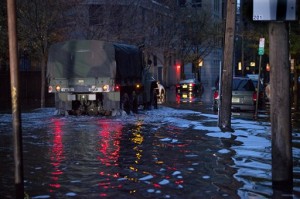US region hit by Sandy slowly resumes daily life

A National Guard truck drives through high water on Newark Street in Hoboken, New Jersey Wednesday in the wake of superstorm Sandy. AP PHOTO
NEW YORK — People in the battered US East Coast corridor took the first cautious steps to reclaim their upended daily routines Wednesday, even as the National Guard searched for flood victims in New Jersey and fires still raged two days after superstorm Sandy. Two major airports reopened and the New York Stock Exchange came back to life.
For the first time since the storm pummeled the Northeast, killing 59 people and doing billions of dollars in damage, brilliant sunshine washed over the nation’s largest city — a striking sight after days of gray skies, rain and wind.
At the stock exchange, running on generator power, Mayor Michael Bloomberg gave a thumbs-up and rang the opening bell to whoops from traders on the floor. Trading resumed after the first two-day weather shutdown since the Blizzard of 1888.
Kennedy and Newark Liberty airports reopened with limited service Wednesday morning. New York’s LaGuardia Airport, which suffered far worse damage and where water covered parts of runways, remained closed.
It was clear that restoring the region to its ordinarily frenetic pace could take days — and that rebuilding the hardest-hit communities and the transportation networks that link them together could take considerably longer.
Article continues after this advertisementAbout 6.5 million homes and businesses were still without power, including 4 million in New York and New Jersey. Electricity was out as far west as Wisconsin and as far south as the Carolinas.
Article continues after this advertisementThe scale of the challenge could be seen in New Jersey, where National Guard troops arrived in the heavily flooded city of Hoboken to help evacuate thousands still stuck in their homes and deliver ready-to-eat meals. Live wires dangled in floodwaters that Mayor Dawn Zimmer said were rapidly mixing with sewage.
Thousands of people were still holed up in their brownstones, condos, and other homes in the city across the Hudson River from New York.
And new problems arose when firefighters were unable to reach blazes rekindled by natural gas leaks in the heavily hit shore town of Mantoloking. More than a dozen homes were destroyed.
President Barack Obama was planning to visit New Jersey, which was directly in the storm’s path Monday night and where part of the historic boardwalk washed away.
Gov. Chris Christie said he plans to ask the president to assign the Army Corps of Engineers to work on how to rebuild beaches and find “the best way to rebuild the beach to protect these towns.”
As New York began its second day after the megastorm, morning rush-hour traffic was heavy as people started returning to work. There was even a sign of normalcy: commuters waiting at bus stops.
On the Brooklyn Bridge, closed earlier because of high winds, joggers and bikers made their way across the span before sunrise. One cyclist carried a flashlight. Car traffic on the bridge was busy, and slowed as it neared Manhattan.
A huge line formed at the Empire State Building as the observation deck opened for the first time since the storm.
The Brooklyn-Battery Tunnel, connecting Brooklyn to Manhattan, and the Holland Tunnel, between New York and New Jersey, remained closed. But bridges into the city were open, and city buses were running, free of charge.
School was canceled for a third straight day Wednesday in the city, where many students rely on buses and subways to reach classrooms.
Bloomberg said it could take four or five days before the subway, which suffered the worst damage in its 108-year history, is running again. High water prevented inspectors from immediately assessing damage to key equipment.
The chairman of the state agency that runs the subway, Joseph Lhota, said service might have to resume piecemeal, and experts said the cost of the repairs could be staggering.
Power company Consolidated Edison said it could also be the weekend before power is restored to Manhattan and Brooklyn, perhaps longer for other New York boroughs and the New York suburbs.
Amtrak also laid out plans to resume some passenger train service in the Northeast on Wednesday. But flooding continues to prevent service to and from New York’s Penn Station. Amtrak said the amount of water in train tunnels under the Hudson and East rivers is unprecedented.
There was no Northeast Regional service between New York and Boston. No date has been set for when it might resume.
In Connecticut, some residents of Fairfield returned home in kayaks and canoes to inspect widespread damage left by retreating floodwaters that kept other homeowners at bay.
“The uncertainty is the worst,” said Jessica Levitt, who was told it could be a week before she can enter her house. “Even if we had damage, you just want to be able to do something. We can’t even get started.”
And in New York, residents of the flooded beachfront neighborhood of Breezy Point returned home to find fire had taken everything the water had not. A huge blaze destroyed perhaps 100 homes in the close-knit community where many had stayed behind despite being told to evacuate.
John Frawley, who lived about five houses from the fire’s edge, said he spent the night terrified “not knowing if the fire was going to jump the boulevard and come up to my house.”
“I stayed up all night,” he said. “The screams. The fire. It was horrifying.”
There were still only hints of the economic impact of the storm.
Forecasting firm IHS Global Insight predicted it would cause $20 billion in damage and $10 billion to $30 billion in lost business. Another firm, AIR Worldwide, estimated losses up to $15 billion.